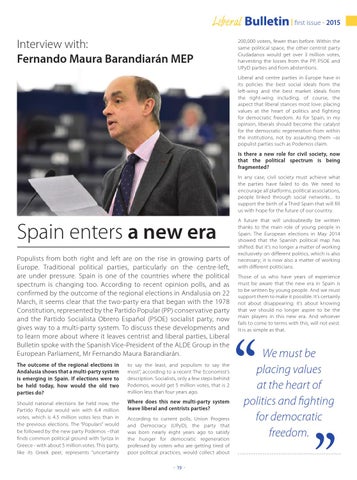first issue - 2015
Interview with: Fernando Maura Barandiarán MEP
200,000 voters, fewer than before. Within the same political space, the other centrist party Ciudadanos would get over 3 million votes, harvesting the losses from the PP, PSOE and UPyD parties and from abstentions. Liberal and centre parties in Europe have in its policies the best social ideals from the left-wing and the best market ideals from the right-wing including, of course, the aspect that liberal stances most love: placing values at the heart of politics and fighting for democratic freedom. As for Spain, in my opinion, liberals should become the catalyst for the democratic regeneration from within the institutions, not by assaulting them –as populist parties such as Podemos claim. Is there a new role for civil society, now that the political spectrum is being fragmented? In any case, civil society must achieve what the parties have failed to do. We need to encourage all platforms, political associations, people linked through social networks... to support the birth of a Third Spain that will fill us with hope for the future of our country.
Spain enters a new era Populists from both right and left are on the rise in growing parts of Europe. Traditional political parties, particularly on the centre-left, are under pressure. Spain is one of the countries where the political spectrum is changing too. According to recent opinion polls, and as confirmed by the outcome of the regional elections in Andalusia on 22 March, it seems clear that the two-party era that began with the 1978 Constitution, represented by the Partido Popular (PP) conservative party and the Partido Socialista Obrero Español (PSOE) socialist party, now gives way to a multi-party system. To discuss these developments and to learn more about where it leaves centrist and liberal parties, Liberal Bulletin spoke with the Spanish Vice-President of the ALDE Group in the European Parliament, Mr Fernando Maura Barandiarán. The outcome of the regional elections in Andalusia shows that a multi-party system is emerging in Spain. If elections were to be held today, how would the old two parties do?
to say the least, and populism to say the most”, according to a recent The Economist’s description. Socialists, only a few steps behind Podemos, would get 5 million votes, that is 2 million less than four years ago.
Should national elections be held now, the Partido Popular would win with 6.4 million votes, which is 4.5 million votes less than in the previous elections. The “Populars” would be followed by the new party Podemos –that finds common political ground with Syriza in Greece - with about 5 million votes. This party, like its Greek peer, represents “uncertainty
Where does this new multi-party system leave liberal and centrists parties? According to current polls, Union Progress and Democracy (UPyD), the party that was born nearly eight years ago to satisfy the hunger for democratic regeneration professed by voters who are getting tired of poor political practices, would collect about - 19 -
A future that will undoubtedly be written thanks to the main role of young people in Spain. The European elections in May 2014 showed that the Spanish political map has shifted. But it’s no longer a matter of working exclusively on different politics, which is also necessary; it is now also a matter of working with different politicians. Those of us who have years of experience must be aware that the new era in Spain is to be written by young people. And we must support them to make it possible. It’s certainly not about disappearing; it’s about knowing that we should no longer aspire to be the main players in this new era. And whoever fails to come to terms with this, will not exist. It is as simple as that.
“
We must be placing values at the heart of politics and fighting for democratic freedom.
”
